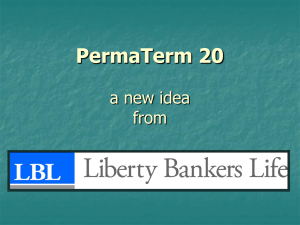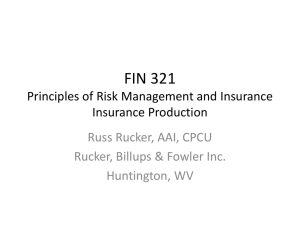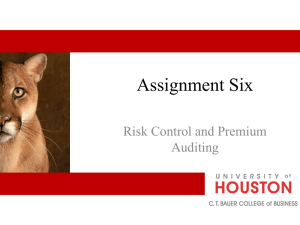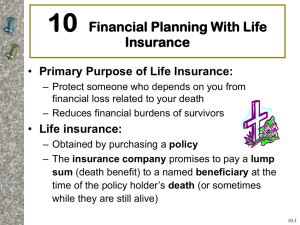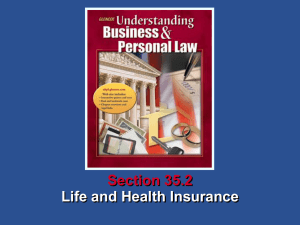Search Frictions and the Cost and Quality of Health Insurance
advertisement
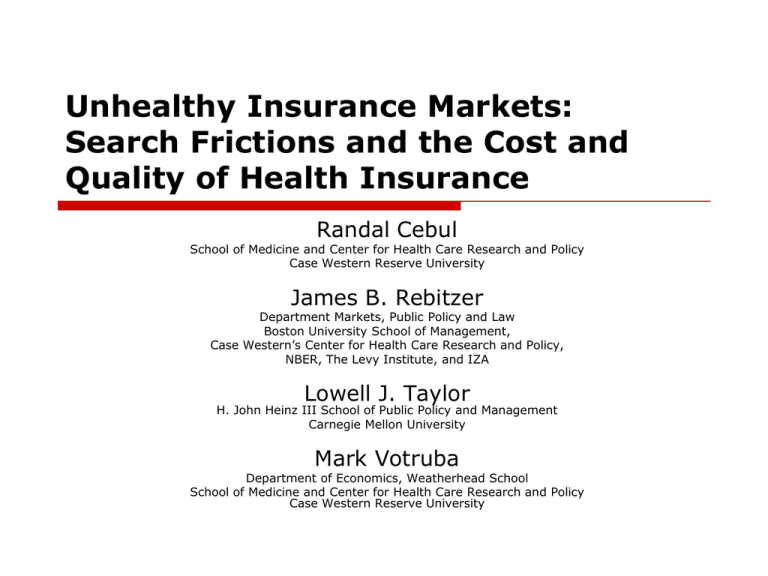
Unhealthy Insurance Markets: Search Frictions and the Cost and Quality of Health Insurance Randal Cebul School of Medicine and Center for Health Care Research and Policy Case Western Reserve University James B. Rebitzer Department Markets, Public Policy and Law Boston University School of Management, Case Western’s Center for Health Care Research and Policy, NBER, The Levy Institute, and IZA Lowell J. Taylor H. John Heinz III School of Public Policy and Management Carnegie Mellon University Mark Votruba Department of Economics, Weatherhead School School of Medicine and Center for Health Care Research and Policy Case Western Reserve University A Prosaic Beginning: The Shopping Problem The Health Insurance Shopping Problem Health Insurance is a complex multi-attribute service. Savvy purchasers must consider: which drugs are in the insurer’s formularies, which local physicians are part of the insurer’s provider network, what co-pays and deductibles apply to which pharmaceuticals, providers and services Delivery of services under hard-to-anticipate contingencies. Medical underwriting and the great profusion of insurance products increases administrative costs and search complexity. Overcoming these challenges entails costs and these costs create search frictions. The Health Insurance Shopping Problem In the US, large and sophisticated employers can simplify the shopping problem by “self insuring” and hiring insurers simply to administer their plans. Smaller and less sophisticated firms “fully insure”, i.e. they buy both administrative services and insurance. These “fully insured” employers have a particularly daunting shopping problem: they know less and the service they buy is more complex. Brokers can, in theory, help. In practice broker advice influenced by the fact that they receive commissions from insurers. The Effects of Search Frictions We study the effect of search frictions on the operation of the commercial health insurance market – especially the “fully insured” market segment. Little attention has been given to the issue of search frictions. Important exceptions: Brown and Goolsbee’s (2002) study showing significant search frictions in the term life insurance market prior to advent of the internet-based comparison shopping. Frank and Lamiraud ( 2008) report evidence of significant price dispersion for homogenous products in Swiss health insurance markets. The Effects of Search Frictions: Theory Results Burdett-Mortensen model adapted to health insurance setting. Key results: Law of One Price doesn’t hold. Identical products priced differently and the distribution of prices is right skewed. Moderate frictions high policy-holder turnover rates The magnitude of frictions can be inferred from the distribution of premiums Search frictions lead insurers to adopt inefficiently high marketing expenditures. Theory Results: Why Inefficiently High levels of Marketing? In frictional insurance markets p> MC, so insurers always want more clients and will spend resources to attract them. Insurance companies with high p gets greater return from marketing than low price plan and so will pay higher commissions. The result is an arms race in marketing –especially in FI plans. Social welfare would be improved with lower commissions, but no insurer will unilaterally cut their payments. Not much data on insurance plans, but Litow using data from large actuary firm reports that administrative expenses were 21% of premium in small group market and 11.5% in large groups. Almost all this diff is due to commissions that are 8.5% of premiums Empirical Results I : Excess Insurance Turnover Data: Household Survey component of the Community Tracking Study (CTS); proprietary information from the enrollment records of a large regional insurer. We find High rates of health insurance cancellation rates (20%/year). Rates of turnover are higher for “fully insured” groups (30%/year) than for self insured (14%) For the average “fully insured”, roughly 60% of this turnover is in fact due to cancellations by entire employer groups. For “self insured”, only 10% of turnover due to employer group turnover. Empirical Results II: Excess Price Dispersion Data: The Robert Wood Johnson Foundation Employer Health Insurance Survey (EHIS) from 1997 The variance in the residual distribution of premiums is greatest in the fully insured market segment where frictions are greatest. The skewness of the residual distribution is greatest for fully insured. Empirical Results III: Structural Estimates Fitting our theoretical model directly to the data yields parameter estimates suggesting moderate search frictions. Market frictions are severe enough to: Transfer ~ 13.2% of consumer surplus to insurers (~$34B in 1997). Increase the insurance turnover about 64% for the average insurance policy. Caveat: structural estimation presumes a correct model. If the fit to the data is poor or if parameter values are crazy, can cast doubt on adequacy of the chosen model. Structural estimation does not rule the possibility that other models might do as well or better. Policy Implications Moderate search frictions transfer substantial surplus to insurers; and support high levels of insurance turnover. Friction induced turnover reduces incentives to invest in future health of policy holders. Policy Responses? Use IT to make comparison shopping easier. Reduce excess variety of plans. Thin the right tail of premium distribution: public option? Medical loss ratio regulation? Regulate brokers? Plan of Talk Sketch out search model and its key predictions for insurance turnover and insurance premiums. Examine the distribution of premiums. Is residual variance and skewness greatest where frictions are greatest? Fit the theoretical model to the data to estimate “search friction” parameter. Are the parameters we uncover consistent with other data? What implications do these parameters have for the efficiency of insurance markets? What implications do these parameters have for incentives to invest in future health. For public insurance options? Modeling Insurance Search: Setup Two market actors: insurances companies and clients Clients are employers who purchase on behalf of their employees. Problematic Information flows Insurers post a premium. Offers arrive at clients via a random process at rate, l. Clients choose the lowest price plan. Contracts last one year Clients exit the relationship in one of two ways. Exogenous separation: which occurs at rate d. Endogenous separation: the client finds a better deal elsewhere. Market friction parameter, g = d/l. As g increases so do frictions. Solve for steady state solutions in continuous time. Modeling Insurance Search: Price Dispersion Insurers can reach only a limited number of clients. Perhaps due to the costs of marketing, e.g. the costs of hiring sales people or paying brokers Perhaps due to client’s limited “mental shelf space”. Offers arrive randomly, so some clients will receive many offers and others only one or two. This latter possibility makes it profitable for some insurers to charge high prices for their product. Many, perhaps most, clients will decline these high priced products. For a few clients, however, the high priced offer will be the best they receive. Modeling Search Frictions: Price Dispersion Suppose all firms set p=c, so p=0 A maverick firm could earn positive expected profits by charging a discretely higher premium, p. The high offer will sometimes be accepted if the contacted client receives no better offer. Supposed all firms set p>c, so p>0 A maverick firm will do better by charging a price slightly less than p, thereby increasing the number of clients while reducing profit per client by a negligible amount. Insurers must therefore be playing mixed strategies. Modeling Search Frictions: the equilibrium distribution of premiums. In order for profits to be identical for all insurers, the entire distribution of offers and acceptances must take a certain shape. For a high priced insurer, if there are too many competitors offering a lower price, the rate of acceptance of offers and hence expected profits will be too low. Conversely if there are too few competitors offering a lower price, the rate of acceptance of high priced offers and expected profits will be too high. Requiring that high price insurers make the same profit as lower priced insurers therefore determines the shape of the cdf of premiums, F(p) Somewhat miraculously, the B-M framework allows for a simple closed-form solution for the cdf of premiums. Modeling Search Frictions: The equilibrium distribution of premiums Knowing the equilibrium cdf of premiums allows us to know the premium that prevails at every quantile of the distribution Thus, the lowest premium in the distribution is: 2 g d R R plowest = c p c with g . and p = p highest g 1 l Note: even the lowest premium exceeds cost because frictions give insurers market power. As frictions increase, insurers gain market power and so the lowest premium offered rises higher above costs. Modeling Search Frictions: More on The Distribution of Accepted Offers We can generalize the previous result for any quantile, q, 2 g g R R pq = c ( p - c) , p0.5 = c ( p - c) g 1 q g 0.5 2 Integrating over the distribution gives us average price g p = c p c p0.5 g 1 R So long as the market friction parameter is neither zero nor infinity, the average premium exceeds the median premium, p.5 Competition pushes the distribution of premiums towards their lower bound, c, but so long as markets have moderate frictions, there will be a long right tail of premiums. Search Frictions and Switching Costs: Firms switch insurers when the gains in terms of better premiums exceed the costs of switching If market frictions were quite small (g ~0) or, large (g approaching infinity), the distribution of premiums would be narrow and gains from switching insurers would likely not exceed the switching costs. High insurance turnover rates with positive switching costs is evidence for intermediate levels of market frictions. Key: Friction induced churn involves the movement of entire employer groups as clients exit after having found a better deal at a competing insurer. This is what we find, especially in the fully-insured market segment. Premiums Data For FI and SI Plans from EHIS Distribution of Raw Premiums: Mean premiums are very close, but variance and skew is larger for FI Frictions Create Premium Variation For Similar Plans at Similar Firms Search frictions result produce price dispersion for “identical” products. If frictions are greater in FI than SI employer group markets, we should expect to see greater variance and skewness of “residual” distributions where the influence of observable client and product characteristics are removed. The premium prediction models were estimated via GLM using the log “link” function and gamma distributional family. Similar results from OLS. Separate regressions were run for FI and SI plans Both regressions included identical covariates measuring plan and establishment characteristics Plan type (PPO/POS), deductible level, co-payment for typical office visit, the inclusion of prescription drug coverage, firm and establishment size, percent of workers who are full-time, percent female, age distribution of workers, state and mean payroll. Distribution of Residual Premiums: Comparison of FI and SI Premium Residuals Figure 1: Premium Variance in FI vs. SI by Firm Size Assessment We find that the variance and skewness of residual premium distributions is greatest for the FI market segment where search frictions are more important. It turns out that one can do much more than this. It is possible to fit the theoretical distribution of premiums to the empirical distribution and back out some of the deeper parameters of the model. Fitting our Search Model to the Data 2 g p qi , Ei = p r qi , Ei = c p c e Ei . g 1 qi R r(θiEi ) is the residual due to the firms random draw from distribution of premiums due to search frictions and the random draw from a nuisance distribution. We assume that e is a mean zero random variable with variance equal to variance in residual in the SI market. We begin assuming that θi=Ei and then “fit” the model to the data to get starting values of parameters. With these starting values we create a simulates distribution of premiums by taking 100,000 independent draws of θi, and Ei . We calculate the values of θ and E at each percentile and use these to re-fit the model. Results are based on 20 iterations, Table 12. Estimates of Market Frictions and Insurance Cost for Fully Insured Employers Panel A: Fitted Models Parameter model 1 model 2 136.4 (3.8) .152 (.025) 433.9 (31.7) 142.1 (3.2) .121 (.018) 453.6 (29.8) Estimates c γ pR 200 0 100 -100 Mean Absolute Deviation is $1.7 / month 300 The Model Fitted at Each Percentile 0 20 40 60 Percentile of residual Empirical residual 80 Simulated residual 100 Is c = $136 per month plausible? Estimates of c using aggregate data Total private insurer spending on health care was $320b in 1997, and 188 million persons were covered by private insurance at some point during the year. (320b/188m)/12 = $142 per member per month The implied load factor If c =$136 pmpm then monthy premiums exceed costs in the FI market by 27% in 1997. Brown and Finkelstein ( 2007 ) find that for long-term care insurance; policy holders receive $0.82 in benefits for every premium dollar spent. This result implies that the ratio of the discounted present value of premiums to the discounted present value of expenditures by insurers is 1.22. Is PR= $433 reasonable? Hornstein, Krusell and Violante ( 2007) note, in frictional markets the maximum willingness to pay will equal the maximum observed premium so long as the efficacy of search for insurance is unrelated to current insurance status. Our model 1 estimate of pR = $433.9 seems reasonable as it lies about 5% above the premium at the 99th percentile of the adjusted distribution ($415.2) What does γ= 0.152 mean? Transfer of surplus from employers to insurance companies The monthly consumer surplus is pR – c = $297.5 The fraction of this accruing to insurers is γ/(g +1) = .132 Summing over 73.1 million policy holders in the FI market, the implied transfer is $34.4B in 1997 What does γ= 0.152 mean? High Rates of Turnover We observe the distribution of accepted offers, but turnover is determined by the distribution of offers. l F ( p) F ( p) = l F ( p) d F ( p) g The average accepted offer sits at the 27th percentile of the distribution of offers. the fraction of group turnover due to endogenous separations is Thus at the mean, frictions increase turnover by .27/(.27+.152)= 64% What does γ= 0.152 mean? Uninsurance In the Burdett-Mortensen framework, the distribution of prices is bounded from above by employers’ maximum willingness to pay. In the real world, of course, many employer groups don’t offer insurance because the price exceeds their reservation price. To the extent that “affordability” contributes uninsurance, we would expect our estimate to understate total rates of uninsurance – perhaps by substantial amounts. Consistent with this expectation, our estimate of g implies a frictional uninsurance rate = 0.135, far less than the 41.7 percent of employers in the EHIS who report not offering health insurance in 1997. We attribute excess price dispersion to seach frictions. Our calculation of excess price dispersion rests on the assumptions that premiums in the self insured market reflect variations in the marginal cost of insurance, and unobservables in the self insured market have the same effect on premiums in the fully insured market as they do in the self insured market. If assumption 1 is wrong, our approach leads us to understate the extent of search frictions. We attribute excess price dispersion to seach frictions. Our calculation of excess price dispersion rests on the assumptions that premiums in the self insured market reflect variations in the marginal cost of insurance, and unobservables in the self insured market have the same effect on premiums in the fully insured market as they do in the self insured market. If assumption 2 is violated by adverse selection from SI to FI market, this will reduce the right skew of premium distributions and cause us to underestimate frictions. Implications for Health Policy I Make shopping easier: Recent IRS, HHS and DOL guidelines might help, but recent guidelines don’t seem very effective. See here Clever uses of IT might be helpful. Reduce excessive variety of plans Implications for Health Policy II In a frictional insurance market, heightened turnover and rent transfer reduce the payoff to investing in the future health of employees. True for relationship specific investments True general investments whether financed by employer or employee This has important implications for the problem of managing chronic diseases. Implication for Health Policy III: Thin the Right Tail of Price Distribution The marketing arms race is driven by the small number of plans on the right tail of the premium distribution. These plans have highest markups and will benefit most from raising commissions. Lower priced plans have to match these payments to brokers in order to attract clients. How to thin right tail? Subsidized public option Minimum medical loss ratio rules Implications for Health Policy IV Many FI employers in our study were using brokers, yet we find evidence of search frictions. Why don’t brokers eliminate search frictions? What must we change to ensure that brokers search effectively on behalf of clients?
